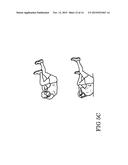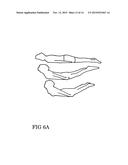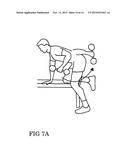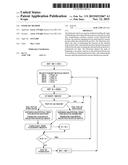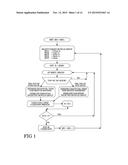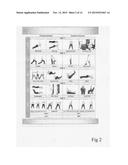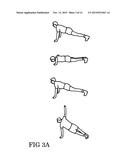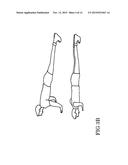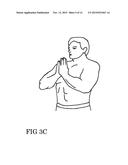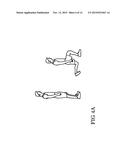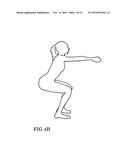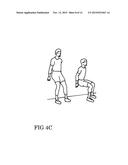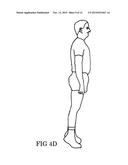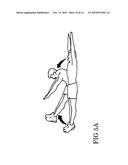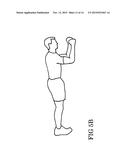Patent application title: Exercise Method
Inventors:
Aaron A Wright (Kansas City, MO, US)
IPC8 Class: AA63B7100FI
USPC Class:
434247
Class name: Education and demonstration physical education
Publication date: 2015-11-12
Patent application number: 20150321067
Abstract:
The disclosure shows an exercise method including the steps of
identifying a first selected body portion to exercise on a first day,
commencing a primary exercise on the selected body portion, the exercise
requiring activity performed by muscle groups within the selected body
portion. The disclosure also shows the step of terminating the exercise
on the selected body portion after a preselected exercise duration has
passed followed by the step of resting the selected body portion for a
preselected rest time. The disclosure depicts the steps of beginning a
secondary exercise on the preselected body part at a conclusion of the
preselected rest time, and continuing the exercise until the preselected
exercise duration has passed.Claims:
1. An exercise method adaptable for use by a person participant, the
method comprising the steps of: identifying a first selected body portion
to exercise on a first day; commencing a primary exercise on the selected
body portion, the exercise requiring activity performed by muscle groups
within the selected body portion; terminating the exercise on the
selected body portion after a preselected exercise duration has passed;
resting the selected body portion for a preselected rest time; beginning
a secondary exercise on the preselected body part at a conclusion of the
preselected rest time, and continuing the exercise until the preselected
exercise duration has passed.
2. The exercise method as in claim 1, the preselected exercise duration comprising sixty seconds.
3. The exercise method as in claim 1, the preselected rest time comprising fifty nine minutes.
4. The exercise method as in claim 1, wherein each of the commencing step and the beginning step is performed at a top of an hour.
5. The exercise method as in claim 1, further comprising the steps of: repeating the commencing step a predetermined number of times.
6. The exercise method as in claim 5, wherein the predetermined number of times is between three times and ten times.
7. The exercise method as in claim 1, wherein the primary exercise is identical to the secondary exercise.
8. The exercise method as in claim 1, wherein the primary exercise is an isometric exercise and the secondary exercise is an isotonic exercise.
9. The exercise method as in claim 1, wherein the first selected body portion comprises a chest of the participant person.
10. The exercise method as in claim 9, wherein the primary exercise comprise push ups.
11. The exercise method as in claim 9, wherein the secondary exercise comprise an isometric chest press.
12. The exercise method as in claim 1, further comprising the step of identifying a second selected body portion to exercise on a second day.
13. The Exercise method as in claim 12, the second body portion comprising a participants legs.
14. The exercise method as in claim 12, wherein the primary exercise on the second day comprise squats.
15. The exercise method as in claim 12, wherein the secondary exercise on the second day comprise a wall leg press.
16. The exercise method as in claim 1, further comprising the step of identifying a third selected body portion to exercise on a third day.
17. The exercise method as in claim 16, wherein the third selected body portion comprises arms.
18. The exercise method as in claim 16, wherein the primary exercise comprises an arm curl.
19. The exercise method as in claim 16, wherein the secondary exercise comprises an isometric bicep press.
20. The exercise method as in claim 1, further comprising the step of identifying a fourth selected body portion to exercise on a fourth day.
21. The exercise method as in claim 20, wherein the fourth selected body portion comprises the abdominals of the participant person.
22. The exercise method as in claim 20, wherein the primary exercise on the fourth selected body portion comprises abdominal crunches.
23. The exercise method as in claim 20, wherein the secondary exercise on the fourth selected body portion comprises V-ups.
24. The exercise method as in claim 1, further comprising the step of identifying a fifth body portion to exercise on a fifth day.
25. The exercise method as in claim 24, the fifth body portion comprising the back of the participant person.
26. The exercise method as in claim 24, the primary exercise comprising a supported bridge exercise.
30. An exercise method adaptable for use by a person participant, the method comprising the steps of: on a first day of a week, perform a chest exercise for sixty seconds followed by fifty nine minutes of rest; on a second day of the week, perform an arm exercise for sixty seconds followed by fifty nine minutes of rest; on a third day of the week, perform an abdominal exercise for sixty seconds followed by fifty nine minutes of rest; on a fourth day of the week, perform a leg exercise for sixty seconds followed by fifty nine minutes of rest; on a fifth day of the week, perform a back exercise for sixty seconds followed by fifty nine minutes of rest; repeating the performing and resting steps at least five times on each of the respective first through fifth days.
31. The exercise method as in claim 30, wherein chest exercise includes a push up.
32. The exercise method as in claim 30, wherein the chest exercise includes an isometric press.
33. The exercise method as in claim 30, wherein the arm exercise includes an arm curl.
34. The exercise method as in claim 30, wherein the arm exercise includes an isometric bicep press.
35. The exercise method as in claim 30, wherein the abdominal exercise includes a V-up.
37. The exercise method as in claim 30, further comprising the step of engaging in at least thirty minutes of cardiovascular exercise on the sixth day of the week.
38. The exercise method as in claim 37, further comprising the step of resting on the seventh day of the week.
39. The exercise method as in claim 30, wherein the first day, second day, third day, fourth day, fifth day, fifth day, sixth day, and seventh day comprise consecutive days.
40. An exercise method adaptable for use by a person participant, the method comprising the steps of: on a first day of a week, perform for sixty seconds a first set of repeated isotonic chest exercises comprising one of push ups, modified wall push ups, or windmill exercise; followed by fifty nine minutes of rest, then a first sixty-second performance of an isometric chest exercise including one of an isometric fly press, or a dual hand press followed by fifty nine minutes of rest, then perform for sixty seconds a second set of isotonic chest exercises comprising one of push ups, modified wall push ups, or windmill exercise followed by fifty nine minutes of rest then a second sixty second performance of the isometric chest exercise including one of an isometric fly press, or a dual hand press followed by fifty nine minutes of rest, then perform for sixty seconds a third set of repeated isotonic chest exercises comprising one of push ups, modified wall push ups, or windmill exercise followed by fifty nine minutes of rest then a third sixty second performance of the isometric chest exercise including one of an isometric fly press, or a dual hand press followed by fifty nine minutes of rest, followed by a sixty-second fourth set of repeated isotonic chest exercises comprising one of push ups, modified wall push ups, or windmill exercise; followed by fifty nine minutes of rest, then a fourth sixty-second performance of an isometric chest exercise including one of an isometric fly press; on a second day of the week, perform a sixty-second first set of repeated isotonic leg exercises including one of squats or alternating single-leg forward lunges followed by fifty-nine minutes of rest, then perform a sixty-second isometric leg exercise including one of a wall-sit exercise or the rocket stand exercise followed by fifty-nine minutes of rest, then perform a second sixty-second set of repeated isotonic leg exercises including one of squats or alternating single-leg forward lunges followed by fifty-nine minutes of rest, then perform a sixty-second isometric leg exercise comprising one of wall-sit exercise or rocket stand exercise followed by fifty-nine minutes of rest, then perform a third set of repeated isotonic leg exercises including one of squats or alternating single-leg forward lunges followed by fifty-nine minutes of rest, then perform a sixty-second isometric leg exercise comprising one of wall-sit exercise or rocket stand exercise followed by fifty-nine minutes of rest, then perform a fourth set of repeated isotonic leg exercises including one of squats or alternating single-leg forward lunges followed by fifty-nine minutes of rest, then perform a sixty-second isometric leg exercise comprising one of wall-sit exercise or rocket stand exercise; on a third day of the week, perform a sixty second first set of repeated isotonic abdominal exercises including one of a standing toe-to-toe twist exercise or a seated bicycle twist exercise, followed by fifty nine minutes of rest, then a sixty second performance of an isometric abdominal exercise including one of a V-up and hold exercise or a horizontal plank exercise, followed by fifty nine minutes of rest, then perform a minute-long second set of repeated isotonic abdominal exercises including one of a standing toe-to-toe twist exercise or a seated bicycle twist exercise, followed by fifty nine minutes of rest, then performance of an isometric abdominal exercise including one of a V-up and hold exercise or a horizontal plank exercise, followed by fifty nine minutes of rest, then perform a third sixty second set of repeated isotonic abdominal exercises including one of a standing toe-to-toe twist exercise or a seated bicycle twist exercise, followed by fifty nine minutes of rest, then performance of an isometric abdominal exercise including one of a V-up and hold exercise or a horizontal plank exercise, followed by fifty nine minutes of rest, perform a fourth sixty second set of repeated isotonic abdominal exercises including one of a standing toe-to-toe twist exercise or a seated bicycle twist exercise, followed by fifty nine minutes of rest, then a performance of an isometric abdominal exercise including one of a V-up and hold exercise or a horizontal plank exercise, on a fourth day of the week, perform a first sixty-second set of repetitive isotonic back exercises including one of a front door row exercise or a paratrooper exercise followed by fifty nine minutes of rest then a sixty second performance of an isometric back exercise comprising one of an isometric row exercise or a seated chair pull exercise followed by fifty nine minutes of rest, and perform a second sixty-second set of repetitive isotonic back exercises including one of a front door row exercise or a paratrooper exercise followed by fifty nine minutes of rest then a sixty second performance of an isometric back exercise comprising one of an isometric row exercise or a seated chair pull exercise followed by fifty nine minutes of rest, and perform a third sixty-second set of repetitive isotonic back exercises including one of a front door row exercise or a paratrooper exercise followed by fifty nine minutes of rest then a sixty second performance of an isometric back exercise comprising one of an isometric row exercise or a seated chair pull exercise followed by fifty nine minutes of rest, and perform a fourth sixty-second set of repetitive isotonic back exercises including one of a front door row exercise or a paratrooper exercise followed by fifty nine minutes of rest then a sixty second performance of an isometric back exercise comprising one of an isometric row exercise or a seated chair pull exercise; on a fifth day of the week, perform a first sixty-second set of repeated isotonic arm exercises including one of bicep curls or kickback tricep extensions followed by fifty nine minutes of rest, then a first sixty second isometric arm exercise including one of a behind the back tricep cord pull exercise and an alternating arm shoulder press exercise followed by fifty nine minutes of rest, then perform a second sixty-second set of repeated isotonic arm exercises including one of bicep curls or kickback tricep extensions followed by fifty nine minutes of rest, then a second performance of a sixty-second isometric arm exercise including one of a behind the back tricep cord pull exercise and an alternating arm shoulder press exercise followed by fifty nine minutes of rest, then perform a third sixty-second set of isotonic arm exercises including one of bicep curls or kickback tricep extensions followed by fifty nine minutes of rest, then performance of a sixty-second isometric arm exercise including one of a behind the back tricep cord pull exercise and an alternating arm shoulder press exercise followed by fifty nine minutes of rest perform a fourth sixty-second set of isotonic arm exercises including one of bicep curls or kickback tricep extensions followed by fifty nine minutes of rest, then a fourth performance of a sixty-second isometric arm exercise including one of a behind the back tricep cord pull exercise and an alternating arm shoulder press exercise; on a sixth day of the week, engage in at least thirty-minutes of cardio-vascular exercise; and, rest on a seventh day of the week.
41. An exercise method comprising the steps of performing a selected exercise for sixty seconds at a top of each hour for a preselected number of consecutive hours.
Description:
BACKGROUND OF THE INVENTION
[0001] The demanding schedules of today's busy world frequently cause people to ignore the need to get physical exercise. Countless studies affirm the general principle that frequent and regular exercise will not only increase physical health, those who find time to exercise frequently and regularly experience mental health benefits as well.
[0002] For example, problems such as low work productivity, illness and time-off work, obesity, and general malaise and disease can be reduced by implementing a regular exercise regimen into daily life. The age-old problem, however, is that our busy lifestyle makes finding a time and place to exercise quite a challenge. The inventive exercise method set forth herein is well-suited for those with high demands for time.
SUMMARY OF THE INVENTION
[0003] The invention is a an exercise method adaptable for use by a person participant, and includes the step of identifying a first selected body portion to exercise on a first day, then commencing a primary exercise on the selected body portion. This chosen exercise will require activity to be performed by muscle groups within the selected body portion. Next, the invention includes the step of terminating the exercise on the selected body portion after a preselected exercise duration has passed. In a preferred embodiment, one terminates the exercise on the selected body portion after sixty seconds. Next, the invention includes the step of resting the selected body portion for a preselected rest time. In this preferred embodiment, one performs exercises for one minute each hour, so the preselected rest time would include fifty-nine minutes. It has been found that commencing the exercises at the top of each and every hour of a work day is preferred, as this allows the participant to keep better track of the passing time of the workday, which may enhance one's overall daily productivity, especially when inventive method is implemented by a participant during one's workday.
[0004] The invention will also include the step of beginning a secondary exercise on the preselected body part at a conclusion of the preselected rest time, and continuing the exercise until the preselected exercise duration has passed. In a preferred embodiment of the inventive method, the primary exercise and secondary exercises are identical to one another, of course, the primary and secondary exercises may differ from one another. For example, the primary exercise may include an isotonic exercise and secondary exercises may be isometric exercises, or vice-versa.
[0005] The inventive exercise method may further include the step of identifying a second selected body portion to exercise on a second day, and in like manner identifying a third selected body portion to exercise on a third day, and in like manner identifying a fourth selected body portion to exercise on a fourth day, and in like manner identifying a fifth selected body portion to exercise on fifth day. For example, the first body portion may include the chest, the second body portion may include legs, the third body portion may include arms, the fourth body portion may include abdominals (aka core), and the fifth body portion may comprise the back.
[0006] In these embodiments of the various days, the primary exercise on the first day may include pushups as an isotonic exercise, and an isometric chest press as the secondary exercise on the first day. Moreover, the primary exercise on the second day may include squats as an isotonic exercise, or a seated wall-leg press as an isometric secondary exercise.
[0007] Further, the primary exercise on the third day may include arm curls, and the secondary exercise on the third day may include an isometric arm press against a stationery horizontal surface (i.e., the underside of a desk or heavy table, or even the lower portion of the arm of a chair).
[0008] Moreover, the primary exercise on the fourth day may include V-ups, or even a V-up and hold, for a secondary exercise, and the exercises on the fifth day may comprise a supported bridge exercise.
[0009] The inventive exercise method is well-suited toward a the consecutive days of five-day workweek, as these primary and secondary exercises may be performed at hourly intervals during one's regular workday. Taking one minute at the top of each hour of a workday will not only help reduce one's daily stress, it may also provide periodic reminders as to the time requirements of the workday. On the sixth day, one may choose any physical activity of one's own choosing, such as a long walk, a couple sets of tennis, a game of basketball, or any activity that would raise one's heartrate for at least a half an hour. Also, the inventive exercise may require that one rest on the seventh day after completing six consecutive days of these series of daily requirements.
[0010] Other objects, advantages and novel features of the present invention will become apparent from the following detailed description of the invention when considered in conjunction with the accompanying drawings.
BRIEF DESCRIPTION OF THE DRAWINGS
[0011] FIG. 1 is a flowchart diagram detailing steps of the exercise method, according to the principles of the invention.
[0012] FIG. 2 is a diagram setting forth a pictorial explanation of the method, shown incorporating a plurality of isometric and isotonic exercises.
[0013] FIGS. 3A-3C depict respective exercises that target the chest muscle groups of the participant.
[0014] FIGS. 4A-4D depict respective exercises that target the leg muscle groups of the participant.
[0015] FIGS. 5A-5C depict respective exercises that target the core muscle groups of the participant.
[0016] FIG. 6A depicts an exercise that targets the back muscles of the participant.
[0017] FIG. 7A depicts an exercise that targets the arm muscles of the participant.
DETAILED DESCRIPTION OF PREFERRED EMBODIMENTS
[0018] FIG. 1 is a flowchart diagram giving the basic steps of the inventive exercise method, according to the principles of the invention. This method takes aim at each of five (5) different muscle groups, each respective muscle group being targeted on its respective day of the week. As shown in FIG. 1, the Muscle Group Selection comprises a primary step of the inventive method, and implicit within this Muscle Group Selection Process is the step of assigning a muscle-group number to each of the chest, legs, core/abdominals, back, and arms. FIG. 1 depicts the chest as muscle group one, the legs as muscle group 2, the core/abs as muscle group 3, the back as muscle group 4 and the arms as the fifth muscle group. Of course, the order and selection of the targeted muscle groups may be changed to meet the preference of the individual.
[0019] Still referring to FIG. 1, the inventive method requires one to begin one's day at rest; however, at a pre-selected time of each hour, one should perform an exercise for a preselected amount of time. In a preferred embodiment of this step of the invention, one performs an exercise for sixty seconds, commencing at the top of each hour.
[0020] As shown in FIG. 1, the invention preferably requires the participant to alternate between isotonic (moving the muscles through a range of motion) exercise, and an isometric (stressing/flexing the muscles while stationary) exercise. FIG. 1 depicts that the participant will express gratitude, then perform a one-minute isotonic exercise at the top of every even-numbered hour (i.e., 8:00 am, 10:00 am, 12:00 pm, and so forth). FIG. 1 also shows that the participant will express gratitude, then perform a one-minute isotonic exercise at the top of every odd-numbered hour (i.e., 9:00 am, 11:00 am, 1:00 pm, and so forth). During this step of the inventive method, the participant should select a respective exercise that targets the muscle-group selected at the commencement of the day.
[0021] Once the participant completes the exercise for a preselected period, the participant should relax all muscles, and take a large, deep cleansing breath, and may be followed by (or simultaneous with) an expression of gratitude. Preferably, the expression of gratitude is made audibly and/or tangibly. In a preferred embodiment of the method, the expression of gratitude is logged in writing into a personal exercise journal that may be kept by the participant.
[0022] Still referring to FIG. 1, the participant repeats the step of performing an exercise on the top of each hour for a predetermined number of times. FIG. 1 shows a method wherein the participant performs a one-minute exercise at the top of eight consecutive hours. If the participant performs the invention as set forth in FIG. 1, then the participant will have performed four one-minute episodes of an isotonic exercise on the targeted muscle group, and will have also performed four one-minute episodes of an isometric exercise on the targeted muscle group, for a total of eight minutes of total exercise, each of which took aim at the targeted muscle group.
[0023] Still referring to FIG. 1, after the completion of a predetermined number of one-minute exercises, the participant has completed the use of the invention for the day; consequently, the participant has also completed the regimen of exercises that took aim at the targeted muscle group. The participant rests for the remainder of the day, then prepares to take aim at the next muscle group on the next day.
[0024] As shown in FIG. 1, the invention requires one to perform the exercises steps for five respective days, each respective day requiring performance of eight one-minute exercises at the top of each of eight consecutive hours, wherein the exercises alternate from isotonic exercises on a respective muscle group to isometric exercises on a respective muscle group. After the fifth day, the sixth and seventh days are tailored to give the participant a break from the routine that is set forth by FIG. 1.
[0025] FIG. 2 shows a pictorial diagram that gives a specific example as to how a participant may incorporate the exercise method into a weekly regimen. As shown in FIG. 2, the participant selects chest as muscle group 1, legs as muscle group 2, core as muscle group 3, back as muscle group 4 and arms as muscle group 5. The specifics of the exercises that target each respective muscle group are depicted hereinafter in greater detail.
[0026] Day One
[0027] Still referring to FIG. 2, the participant may start the day at 8:00 am with an isotonic chest exercise, such as windmills, as shown. After sixty-seconds (or any other pre-selected time chosen by the participant) of performing a chosen isotonic chest exercise, the participant then relaxes, takes a long, deep, and slow breath, then utters an expression of gratitude. Preferably, one will journalize the expression of gratitude before returning to the resting period.
[0028] As shown in FIG. 2, the participant then performs an isometric chest exercise at 9:00 am. The isometric exercise at 9:00 may be an isometric chest push, for example. After one minute, the participant relaxes, takes a long deep and slow breath, then utters an expression of gratitude. Preferably, journalizes the expression of gratitude before returning to the resting period.
[0029] Still referring to FIG. 2, the participant at 10:00 am performs another isotonic chest exercise. In this embodiment, the participant may choose to repeat the earlier-performed exercise (windmills), or may opt for a different isotonic chest exercises, such as push-ups for example. After sixty-seconds (or any other pre-selected time chosen by the participant) of performing the chosen isotonic chest exercise, the participant then relaxes, takes a long, deep, and slow breath, then utters an expression of gratitude. Preferably, one will journalize the expression of gratitude before returning to the resting period.
[0030] Still referring to FIG. 2, the participant then performs an isometric chest exercise at 11:00 am. The isometric exercise at 11:00 may be the same exercise performed at 9:00 am, or it may be a different exercise, such as an isometric fly exercise, for example. After one minute, the participant relaxes, takes a long deep and slow breath, then utters an expression of gratitude. Preferably, journalizes the expression of gratitude before returning to the resting period.
[0031] Viewing FIG. 2 and FIG. 1 together, one performs the one-minute exercise on the chosen, respective muscle group for a pre-selected number of times before the day is complete for the participant. As shown, the participant performs the chest exercises at the top of eight consecutive hours before the day's work is complete, and the next day the participant takes aim at a different muscle group.
[0032] Day Two
[0033] Still referring to FIG. 2, the participant may start the second day at 8:00 am with an isotonic leg exercise, such as leg lunges, as shown. After sixty-seconds (or any other pre-selected time chosen by the participant) of performing a chosen leg exercise, the participant then relaxes, takes a long, deep, and slow breath, then utters an expression of gratitude. Preferably, one will journalize the expression of gratitude before returning to the resting period.
[0034] As shown in FIG. 2, the participant then performs an isometric leg exercise at 9:00 am. The isometric exercise at 9:00 may be a rocket stand, for example. After one minute, the participant relaxes, takes a long deep and slow breath, then utters an expression of gratitude. Preferably, journalizes the expression of gratitude before returning to the resting period.
[0035] Still referring to FIG. 2, the participant at 10:00 am performs another isotonic leg exercise. In this embodiment, the participant may choose to repeat the earlier-performed exercise (leg lunges), or may opt for a different isotonic leg exercise, such as squats for example. After sixty-seconds (or any other pre-selected time chosen by the participant) of performing the chosen isotonic leg exercise, the participant then relaxes, takes a long, deep, and slow breath, then utters an expression of gratitude. Preferably, one will journalize the expression of gratitude before returning to the resting period.
[0036] Still referring to FIG. 2, the participant then performs an isometric leg exercise at 11:00 am. The isometric exercise at 11:00 may be the same exercise performed at 9:00 am, or it may be a different exercise, such as a wall-sit, for example. After one minute, the participant relaxes, takes a long deep and slow breath, then utters an expression of gratitude. Preferably, journalizes the expression of gratitude before returning to the resting period.
[0037] Viewing FIG. 2 and FIG. 1 together, one performs the one-minute exercise on the chosen, respective muscle group for a pre-selected number of times before the day is complete for the participant. As shown, the participant performs these leg exercises at the top of eight consecutive hours before the day's work is complete, and the next day the participant takes aim at a different muscle group.
[0038] Day Three
[0039] Still referring to FIG. 2, the participant may start the third day at 8:00 am with an isotonic core exercise, such as a toe-to-toe twist, as shown. After sixty-seconds (or any other pre-selected time chosen by the participant) of performing a chosen core exercise, the participant then relaxes, takes a long, deep, and slow breath, then utters an expression of gratitude. Preferably, one will journalize the expression of gratitude before returning to the resting period.
[0040] As shown in FIG. 2, the participant then performs an isometric core exercise at 9:00 am. The isometric exercise at 9:00 may be V-Up, for example. After one minute, the participant relaxes, takes a long deep and slow breath, then utters an expression of gratitude. Preferably, journalizes the expression of gratitude before returning to the resting period.
[0041] Still referring to FIG. 2, the participant at 10:00 am performs another isotonic core exercise. In this embodiment, the participant may choose to repeat the earlier-performed core exercise (Toe-to-Toe Twists), or may opt for a different isotonic core exercise, such as a bicycle twist for example. After sixty-seconds (or any other pre-selected time chosen by the participant) of performing the chosen isotonic core exercise, the participant then relaxes, takes a long, deep, and slow breath, then utters an expression of gratitude. Preferably, one will journalize the expression of gratitude before returning to the resting period.
[0042] Still referring to FIG. 2, the participant then performs an isometric core exercise at 11:00 am. The isometric exercise at 11:00 may be the same exercise performed at 9:00 am, or it may be a different exercise, such as a plank exercise, for example. After one minute, the participant relaxes, takes a long deep and slow breath, then utters an expression of gratitude. Preferably, journalizes the expression of gratitude before returning to the resting period.
[0043] Viewing FIG. 2 and FIG. 1 together, one performs the one-minute exercise on the chosen, respective muscle group for a pre-selected number of times before the day is complete for the participant. As shown, the participant performs these core exercises at the top of eight consecutive hours before the day's work is complete, and the next day the participant takes aim at a different muscle group.
[0044] Day Four
[0045] Still referring to FIG. 2, the participant may start day four at 8:00 am with an isotonic back exercise, such as a paratrooper/superman exercise, as shown. After sixty-seconds (or any other pre-selected time chosen by the participant) of performing a chosen back exercise, the participant then relaxes, takes a long, deep, and slow breath, then utters an expression of gratitude. Preferably, one will journalize the expression of gratitude before returning to the resting period.
[0046] As shown in FIG. 2, the participant then performs an isometric back exercise at 9:00 am. The isometric exercise at 9:00 of the fourth day may be an isometric row, for example. After one minute, the participant relaxes, takes a long deep and slow breath, then utters an expression of gratitude. Preferably, journalizes the expression of gratitude before returning to the resting period.
[0047] Still referring to FIG. 2, the participant at 10:00 am performs another isotonic back exercise. In this embodiment, the participant may choose to repeat the earlier-performed back exercise (paratroopers), or may opt for a different isotonic back exercise, such as a door row for example. After sixty-seconds (or any other pre-selected time chosen by the participant) of performing the chosen isotonic back exercise, the participant then relaxes, takes a long, deep, and slow breath, then utters an expression of gratitude. Preferably, one will journalize the expression of gratitude before returning to the resting period.
[0048] Still referring to FIG. 2, the participant then performs an isometric back exercise at 11:00 am. The isometric exercise at 11:00 may be the same exercise performed at 9:00 am, or it may be a different exercise, such as a seated chair-pull exercise, for example. After one minute, the participant relaxes, takes a long deep and slow breath, then utters an expression of gratitude. Preferably, journalizes the expression of gratitude before returning to the resting period.
[0049] Viewing FIG. 2 and FIG. 1 together, one performs the one-minute exercise on the chosen, respective muscle group for a pre-selected number of times before the day is complete for the participant. As shown, the participant performs these back exercises at the top of eight consecutive hours before the day's work is complete, and the next day the participant takes aim at a different muscle group.
[0050] Day Five
[0051] Still referring to FIG. 2, the participant may start the fifth day at 8:00 am with an isotonic arm exercise, such as bicep curl using a dumbbell, as shown. After sixty-seconds (or any other pre-selected time chosen by the participant) of performing a chosen arm exercise, the participant then relaxes, takes a long, deep, and slow breath, then utters an expression of gratitude. Preferably, one will journalize the expression of gratitude before returning to the resting period.
[0052] As shown in FIG. 2, the participant then performs an isometric arm exercise at 9:00 am. The isometric exercise at 9:00 of the fifth day may be a behind Back extension and pull, for example. After one minute, the participant relaxes, takes a long deep and slow breath, then utters an expression of gratitude. Preferably, journalizes the expression of gratitude before returning to the resting period.
[0053] Still referring to FIG. 2, the participant at 10:00 am on day five performs another isotonic arm exercise. In this embodiment, the participant may choose to repeat the earlier-performed arm exercise (curl), or may opt for a different isotonic arm exercise, such as tricep kick-backs, for example. After sixty-seconds (or any other pre-selected time chosen by the participant) of performing the chosen isotonic arm exercise, the participant then relaxes, takes a long, deep, and slow breath, then utters an expression of gratitude. Preferably, one will journalize the expression of gratitude before returning to the resting period.
[0054] Still referring to FIG. 2, the fifth day continues when the participant performs an isometric arm exercise at 11:00 am. The isometric exercise at 11:00 may be the same exercise performed at 9:00 am, or it may be a different exercise, such as an isometric shoulder-raise exercise, for example. After one minute, the participant relaxes, takes a long deep and slow breath, then utters an expression of gratitude. Preferably, journalizes the expression of gratitude before returning to the resting period.
[0055] Viewing FIG. 2 and FIG. 1 together, one performs the one-minute exercise on the chosen, respective muscle group for a pre-selected number of times before the day is complete for the participant. As shown, the participant performs these arm exercises at the top of eight consecutive hours before the day's work is complete, and the participant can look forward to day six.
[0056] Day Six
[0057] As depicted in FIG. 2, day six is specifically left open for the participant to incorporate an extended day of play, which should include at least 30 minutes of cardio-vascular exercise. Examples of a good day-six would be to go on a family bike-ride, go jogging or swimming, or to play a set or two of tennis or racketball. Although FIG. 2 does not show details of the sixth day, many participants with busy schedules during the week engage in the most grueling and challenging exercise on day six.
[0058] Day Seven
[0059] The seventh day intends to serve as a day of rest and relaxation for the participant, and then the cycle begins anew the next day with exercises aimed at the first muscle group (Chest) to be performed for sixty-seconds at the top of each of eight consecutive hours.
[0060] The principles of the inventive exercise method may employ a variety of combinations of exercises. As shown in FIGS. 3A-3C, the participant may employ a plurality of exercises that exercise the chest. As shown earlier, one may perform isometric fly exercises (See FIG. 2) at the top of a selected hour, or one may perform the isotonic exercises of windmill pushups, as shown in FIG. 3A, or one may perform the isotonic exercise of standard pushups, as shown in FIG. 3B, or one may perform the isometric exercise of an isometric chest press, as shown in FIG. 3C.
[0061] As depicted in FIGS. 4A-4D, the participant may employ a plurality of exercises that target the legs. For example, one may perform the isotonic exercise of leg lunges as shown in FIG. 4A, or the isotonic exercise of squats as shown in FIG. 4B. Also, the participant may employ the isometric exercise of wall-sits, as depicted in FIG. 4C, or may perform the isometric rocket-stand exercise depicted in FIG. 4D.
[0062] As shown in FIGS. 5A-5C, the participant may employ a plurality of exercise that target the muscles of the core or abdominals. For example, the participant may perform at the top of the hour the isotonic V-Up exercise as shown in FIG. 5A. Additionally, the participant may employ the isometric plank exercise as shown in FIG. 5B, or may employ the isotonic bicycle twist crunch exercise shown in FIG. 5C.
[0063] The participant may also employ any of a plurality of back-targeted exercises into the inventive exercise method. For example, the participant may perform at the top of an hour the isotonic paratrooper exercise, as shown in FIG. 6A, or may do a repetitive door-row exercise as depicted in FIG. 2. Alternatively, the participant may target the back muscles by performing at the top of each hour an isometric row (FIG. 2) or an isometric chair pull (FIG. 2).
[0064] Additionally, the participant may employ a plurality of exercises that work the arms. For example, one may employ perform at the top of the hour the isotonic tricep kickback exercise, as shown in FIG. 7A. Alternatively, one may employ a bicep over/under curl (See FIG. 2) as an isotonic exercise atop the hour. Moreover, the participant may aloe employ simple dumbbell curls or isometric bicep movements against a staitionary surface, such as a table top or arm of a chair. As shown in FIG. 2, the participant may also employ a tricep behind the back extension or isometric shoulder raise in order to target the arms. The scope and spirit of the inventive method encourages the participant to find respective exercises that take aim at each respective body muscle group. The combinations and permutations of exercises should be changed in order to add variety and avoid mundane repetition.
[0065] Having described the invention in detail, it is to be understood that this description is for illustrative purposes only. The scope and breadth of the invention shall be limited only by the appended claims.
User Contributions:
Comment about this patent or add new information about this topic:
| People who visited this patent also read: | |
| Patent application number | Title |
|---|---|
| 20180214998 | Production Line Provided of One or More Modules for Carrying Containers for Supplying Parts or Components to Assembly Stations Along the Line |
| 20180214997 | ASSEMBLY METHOD FOR DC CONVERTER VALVE |
| 20180214996 | ASSEMBLY METHOD FOR ASSEMBLED CAMSHAFT AND DEVICE THEREFOR |
| 20180214995 | Welding Station |
| 20180214994 | Body Component Having a Tab Element for Pre-Fastening |

